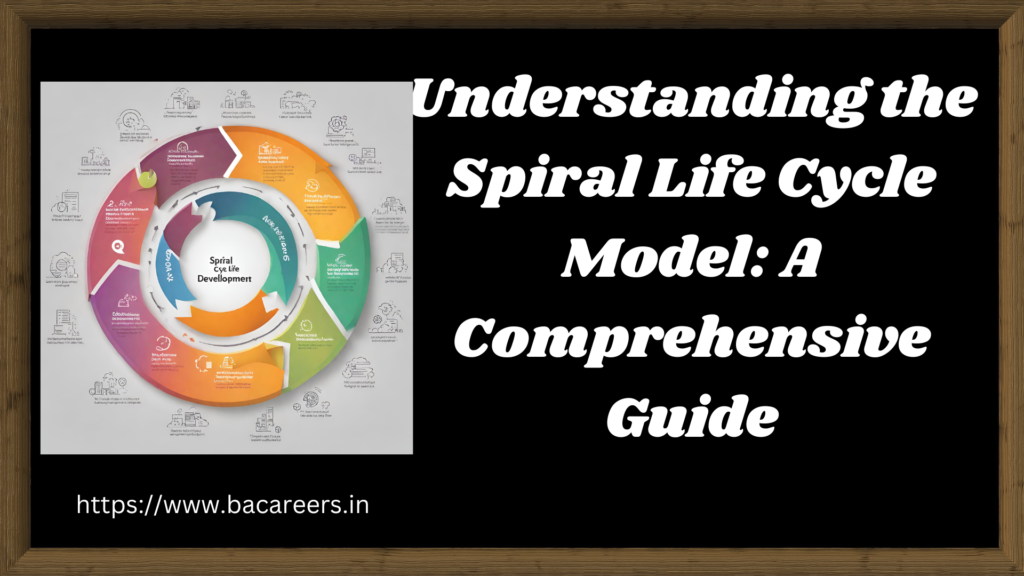In software development, choosing the right development model is crucial for project success. Among the plethora of methodologies available, the Spiral Life Cycle Model stands out as a flexible and iterative approach that accommodates the inherent uncertainties and risks associated with software development. Originally proposed by Barry Boehm in 1986, the Spiral Model combines elements of both iterative development and prototyping in a structured manner. This article delves into the intricacies of the Spiral Life Cycle Model, exploring its principles, phases, and how to effectively utilize it in software projects.

The Spiral Life Cycle Model is a dynamic and iterative software development process that blends elements of traditional waterfall model and prototyping methodologies. This model is designed to accommodate the evolving nature of software projects, allowing for flexibility and adaptation to changes throughout the development lifecycle.
At its core, the Spiral Model consists of four key phases: Planning, Risk Analysis, Engineering, and Evaluation. These phases are repeated in a spiral pattern, with each loop representing a cycle of development. The Planning phase involves defining project goals, requirements, and constraints, while the Risk Analysis phase focuses on identifying and mitigating potential risks.
The Engineering phase encompasses the actual development and testing of the software, with each iteration building upon the previous one. Finally, the Evaluation phase involves reviewing the progress made, gathering feedback, and planning for the next iteration.
One of the key benefits of the Spiral Model is its emphasis on risk management and early detection of issues. By addressing potential risks in the early stages of development, teams can effectively minimize the impact of these risks on the project timeline and budget.
Principles of the Spiral Life Cycle Model
The Spiral Model is founded on several key principles:
- Iterative Development: Unlike traditional linear models like the Waterfall, the Spiral Model embraces iteration. It recognizes that software development is an iterative process where requirements evolve over time.
- Risk Management: One of the distinguishing features of the Spiral Model is its emphasis on risk management. It acknowledges that software projects are inherently risky due to uncertain requirements, technical challenges, and changing environments. The model integrates risk analysis and mitigation strategies into each iteration.
- Prototyping: Prototyping is integral to the Spiral Model. It allows stakeholders to visualize the system early in the development process, gather feedback, and refine requirements iteratively.
- Flexibility: The Spiral Model is highly adaptable to various project types and sizes. It can accommodate both small-scale projects with limited resources and large-scale projects with complex requirements.
Phases of the Spiral Life Cycle Model
The Spiral Life Cycle Model consists of four main phases, which are iteratively repeated throughout the development process:
- Planning: In this phase, project objectives, constraints, and alternatives are identified. This includes defining the scope, schedule, and resources required for the project. Additionally, risk analysis is conducted to identify potential risks and develop mitigation strategies.
- Risk Analysis: Risk analysis is a critical component of the Spiral Model. In this phase, risks are identified, assessed, and prioritized based on their potential impact on the project. Strategies are then developed to mitigate or manage these risks effectively.
- Engineering: The engineering phase involves the development of the software incrementally. Each iteration focuses on implementing a subset of requirements and features. Prototypes may be developed to gather feedback from stakeholders and validate design decisions.
- Evaluation: The evaluation phase involves reviewing the progress made in the previous iterations. This includes assessing the quality of the developed software, identifying areas for improvement, and updating the project plan and risk analysis as necessary. Based on the evaluation, the decision is made to proceed to the next iteration or cycle.
How to Use the Spiral Life Cycle Model
- Define Objectives and Requirements: Clearly define the project objectives and gather requirements from stakeholders. Identify key features and functionalities that need to be developed.
- Risk Analysis and Planning: Conduct a thorough risk analysis to identify potential risks and uncertainties associated with the project. Develop a plan that outlines the project scope, schedule, resources, and risk mitigation strategies.
- Iterative Development: Implement the Spiral Model in iterative cycles. Begin with small iterations focusing on high-priority features. Develop prototypes to gather feedback and refine requirements iteratively.
- Continuous Evaluation and Adaptation: Regularly evaluate the progress made in each iteration. Assess the quality of the software and identify areas for improvement. Update the project plan and risk analysis based on the evaluation findings.
- Iterate: Repeat the cycle of planning, risk analysis, engineering, and evaluation until the project objectives are achieved satisfactorily. Each iteration builds upon the previous one, resulting in a refined and validated software product.
Conclusion
The Spiral Life Cycle Model offers a flexible and iterative approach to software development, particularly suitable for projects with evolving requirements and inherent risks. By integrating risk management, iterative development, and prototyping, the Spiral Model enables teams to effectively manage uncertainties and deliver high-quality software products. By understanding the principles and phases of the Spiral Model and following best practices, software development teams can leverage its benefits to successfully navigate complex projects and deliver value to stakeholders.
Overall, the Spiral Life Cycle Model offers a flexible and adaptive approach to software development, making it a valuable tool for projects with evolving requirements or uncertain constraints. By understanding the principles and phases of this model, teams can enhance their development processes and deliver high-quality software products efficiently.
Related Articles :
Agile Methodology Scrum Master: The Architect of Agile Success
SAFE Certified Scrum Master in Agile Transformations
Who is a Certified Agile Scrum Master?

Business Analyst , Functional Consultant, Provide Training on Business Analysis and SDLC Methodologies.
Author: Pallavi
Business Analyst , Functional Consultant, Provide Training on Business Analysis and SDLC Methodologies. View all posts by Pallavi
